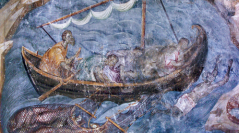

 Anthropozoologica
54 (16) - Pages 179-201
Anthropozoologica
54 (16) - Pages 179-201The paper focuses on fish consumption and long-distance fish trade in the medieval monastery Studenica in Serbia, from the perspective of archaeozoology and historical evidence. Medieval written sources on the subject suggest that fish was available primarily to particular social classes – the royalty, nobles and monasteries. Preserved muniments indicate that during the 13th-15th centuries the majority of distinguished monasteries had their own fishing ponds, fishing grounds and their own fishermen. Fish consumption occupied an important role in monastic contexts, both in Christian religious practices (e.g. Lent) and in celebrations commemorating the Virgin Mary and the monastery founder, during which high-quality fish was obtained from greater distances. The ichthyoarchaeological remains discussed in this paper originate from waste deposition areas within and outside of the ramparts of the Studenica Monastery, accumulated during the 14th and the first half of the 15th century. Apart from the remains of the species available more or less locally (Wels catfish [Silurus glanis Linnaeus, 1758], carp [Cyprinus carpio Linnaeus, 1758], pike [Esox lucius Linnaeus, 1758]), the faunal assemblage contained the remains of migratory sturgeons (beluga [Huso huso Linnaeus, 1758], Russian sturgeon [Acipenser gueldenstaedtii Brandt & Ratzeburg, 1833], stellate sturgeon [Acipenser stellatus Pallas, 1771]) most likely transported from the Danube area, about 200 km away as the crow flies. Skeletal element distribution, butchering traces and size estimations (of beluga in particular) indicate that large specimens (c. 2-3.6 m in total length) were brought whole to the monastery, possibly dried or salted. Their occurrence is an additional indicator of long-distance fish trade recorded in muniments, and it offers new insights into economic, social and religious practices in medieval Eastern Orthodox monasteries.
Medieval fish trade, ichthyofauna, sturgeons, religious celebrations, Studenica Monastery.